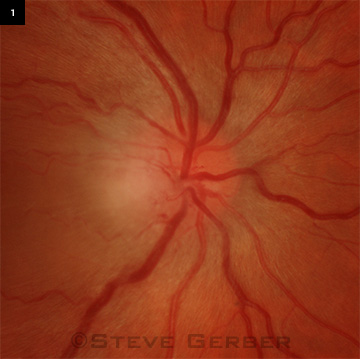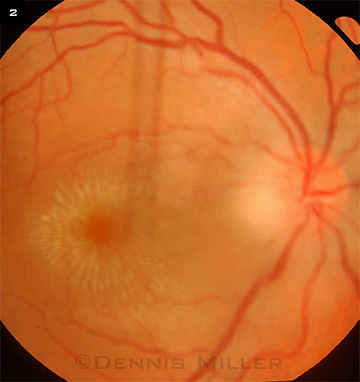Download PDF
As he went to bed one night, Joe Jordan,* a 33-year-old Caucasian man, was worried about his right eye, which had been experiencing blurry vision—both at near and at distance—for two days. When he awoke, he could see only shapes and shadows with that eye, so he went to the emergency room.
We Get a Look
At our initial evaluation in the ER, Mr. Jordan appeared to be healthy. He denied having any eye pain, discharge, headache, double vision, or history of trauma. We noted nothing significant in his medical history, family history, and review of systems. He reported drinking occasionally but had no history of smoking.
His visual acuity was 20/200 in the right eye and 20/20 in the left. Pupils were 4 mm, equal, round, and reactive, but he did demonstrate a mild afferent pupillary defect in his right eye. External examination revealed no ptosis or lid retraction. He had full eye movements without pain. Anterior segment evaluation was normal, with intraocular pressures of 13 mmHg in the right eye and 14 mmHg in the left.
His dilated exam showed a focal round area of elevation on the temporal side of the right optic disc that obscured the border of the nerve (Fig. 1). Edema extended from the nerve temporally toward the macula. The vessels and periphery appeared normal. The left eye was normal.
|
What's Your Diagnosis?
|
 |
|
We noted focal temporal edema in the right eye.
|
Critical Clues
In a young, previously healthy patient with unilateral decreased vision, disc edema, and no headache or pain with eye movement, the differential diagnosis includes many infiltrative and inflammatory processes, such as those due to tuberculosis, Lyme disease, cat-scratch disease, lupus, and sarcoidosis. Optic neuritis related to multiple sclerosis and increased intracranial pressure were less likely because of his lack of relevant symptoms, as well as the focal nature of the optic nerve edema.
In response to further questioning, Mr. Jordan said that he owned a cat, which he recalled “may have scratched him in the past.” We decided to order a number of lab tests, including erythrocyte sedimentation rate (ESR), Bartonella titers for cat-scratch disease, Lyme titers, antinuclear antibodies (ANA), angiotensin-converting enzyme (ACE), and purified protein derivative (PPD), which was administered on his forearm. Although we ordered an MRI, we hoped that the lab tests might make it unnecessary.
Lab Results and Treatment
Five days later the Bartonella henselae IgG titer was positive at 1:256, while Bartonella henselae IgM titer was negative. These results indicated a past or current infection with this organism. Lyme testing was negative, as were the ANA, ACE, and PPD tests. The ESR was mildly elevated at 30 mm per hour.
The presumptive diagnosis was cat-scratch disease, even though Mr. Jordan didn’t have the pathognomonic macular star exudate. He was immediately started on doxycycline, 100 mg twice a day. If his vision improved, the scheduled MRI would be canceled.
When Mr. Jordan came in for his next visit, one week after we initially saw him, he noted subjective vision improvement, and visual acuity in the right eye had improved to 20/100 +2. All other exam findings were normal except for mild blepharitis bilaterally and 2+ temporal edema on his right optic disc. Examination also now revealed macular edema tracking to the fovea with circinate maculopathy (Fig. 2).
These new findings of macular exudates, along with the previous positive lab results, confirmed our original suspicion and diagnosis of neuroretinitis due to a Bartonella infection secondary to cat scratch. Because the edema had not improved, we added ciprofloxacin, 500 mg twice a day, to his medication regimen.
At Mr. Jordan’s two-month follow-up visit, his optic nerve edema had resolved with a small temporal scar on the nerve, and his macular edema was markedly improved. He also demonstrated continued, gradual improvement in his visual acuity, which was 20/30–1 at this visit. We asked him to finish his antibiotic course and return for monitoring in three months’ time, but he did not return to our office.
 |
|
One week after presentation.
|
Discussion
B. henselae, along with B. clarridgeiae, is one of the two bacteria primarily responsible for cat-scratch disease.1 The domestic cat is the primary host; the cat flea is the transmitting vector.2
B. henselae is commonly associated with infectious neuroretinitis, with some studies reporting up to 71 percent of patients with ocular cat-scratch disease presenting with neuroretinitis.3 A hallmark sign of B. henselae is a macular star of lipid deposition. However, this is not always present, especially early in the course of infection,4 although it may develop later in the disease course.5
The typical presentation is unilateral optic nerve edema with painless vision loss in young patients. Central or paracentral visual field defects and afferent pupillary defect are common. Bartonella neuroretinitis is often self-limited, but antibiotics can be used—especially in more severe cases such as this one. Typically, doxycycline or erythromycin is used.
Although Mr. Jordan had some common ocular findings of Bartonella infection—sudden, unilateral vision loss and disc edema as well as an afferent pupillary defect—he did not have the classic macular star exudates at his initial visit. He also did not have systemic symptoms, such as lymphadenopathy, fever, and malaise, which occasionally precede or accompany the ocular manifestations.2 In the absence of some of these characteristics, and relying only on the presence of focal, temporal optic edema in an otherwise healthy patient, we included a wide range of conditions in the differential diagnosis for optic nerve edema.
Because B. henselae is an important component of the differential for unilateral optic nerve edema, patients should be asked about exposure to household pets. Laboratory testing for B. henselae antibodies should be ordered if cat-scratch disease is in the differential diagnosis.
In conclusion, cat-scratch disease should be considered in a patient who has optic nerve edema with vision loss, regardless of whether macular exudates are present.
___________________________
* Patient name is fictitious.
___________________________
1 Klotz SA et al. Am Fam Physician. 2011;83(2):152-155.
2 Roe RH et al. Int Ophth Clin. 2008;48(3):93-105.
3 Channa R et al. JAMA Ophthalmol. 2013;131(11):1477-1478.
4 Solley WA et al. Ophthalmology 1999;106(8):1546-1553.
5 Bhatti MT et al. Arch Neurol. 2001;58(6):1008-1009.
___________________________
Mr. Goldstein is a second-year medical student at Indiana University School of Medicine–South Bend. Dr. Gerber is a practicing ophthalmologist at Advanced Ophthalmology of Michiana in South Bend, Ind. The authors report no related financial interests.